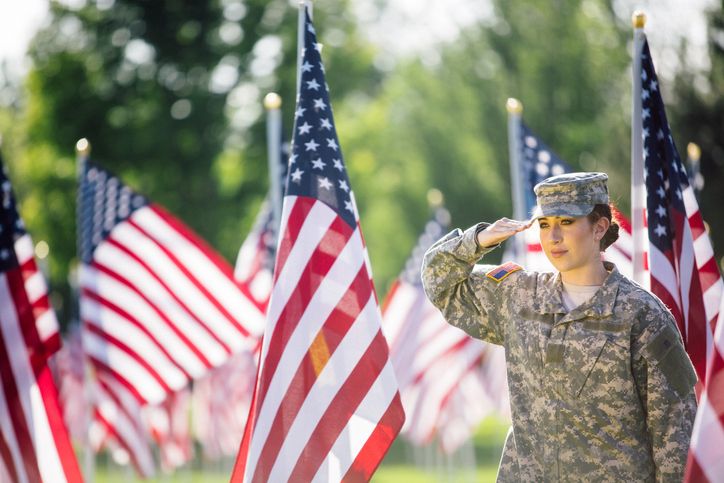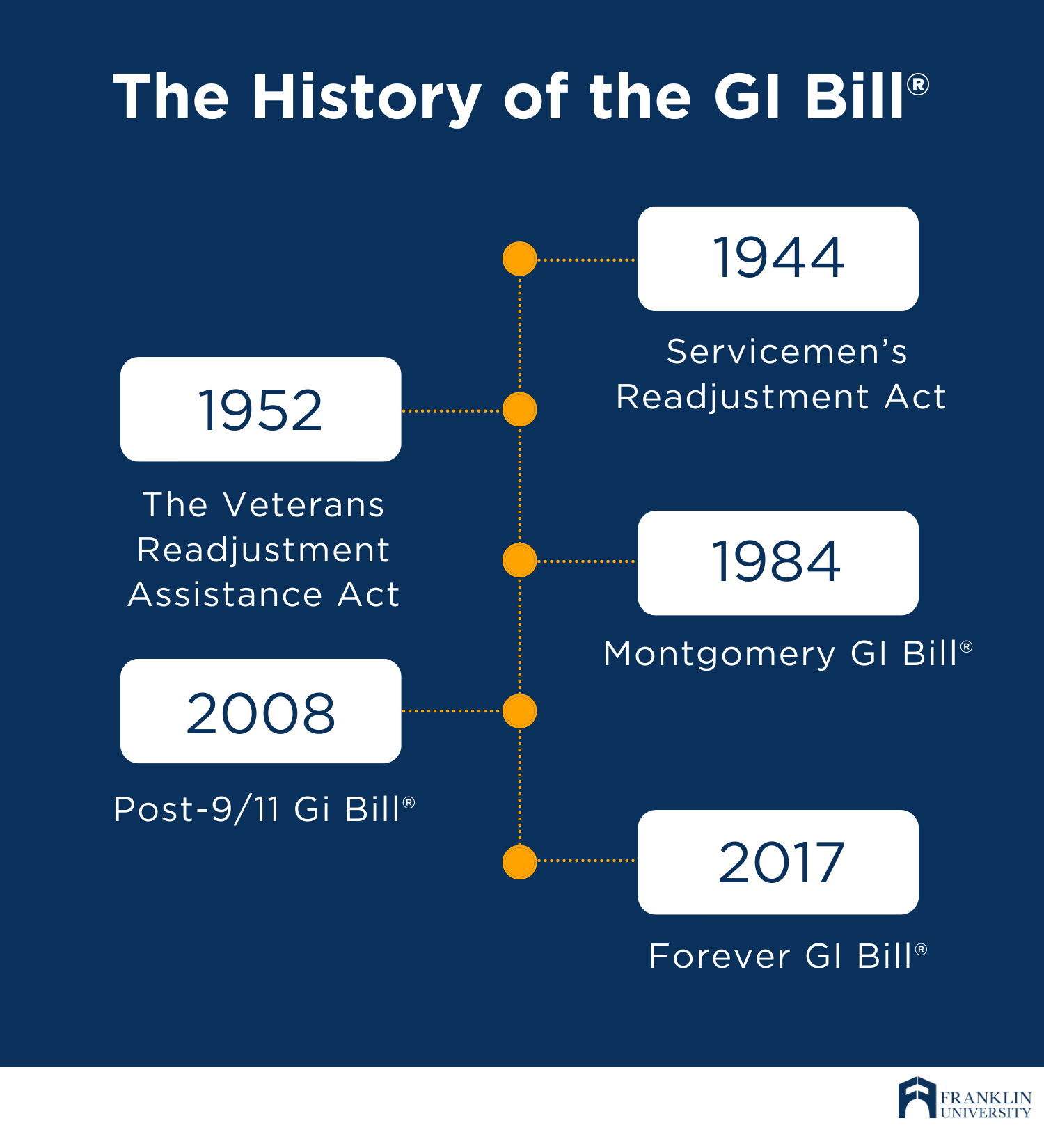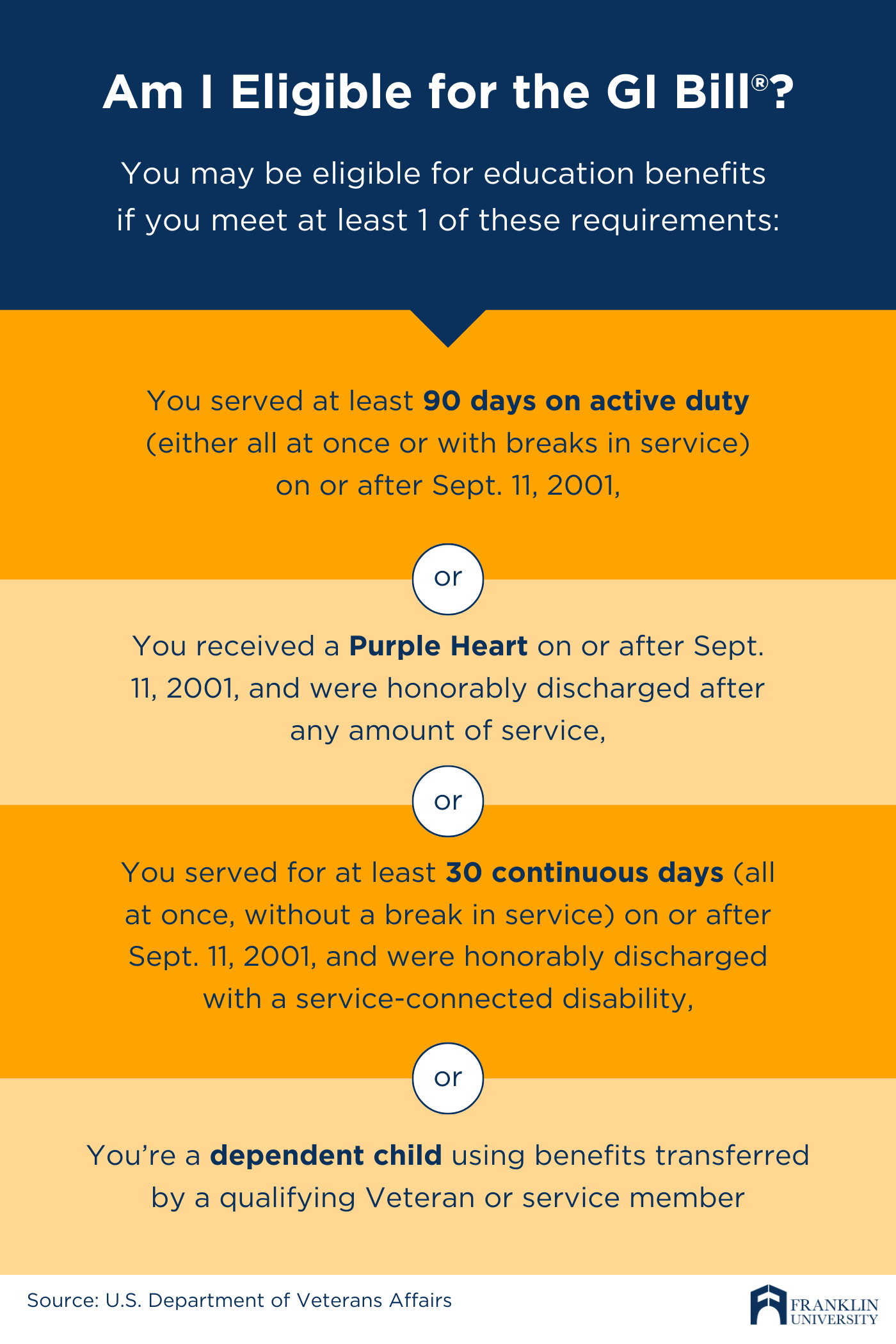Request Information
We're Sorry
There was an unexpected error with the form (your web browser was unable to retrieve some required data from our servers). This kind of error may occur if you have temporarily lost your internet connection. If you're able to verify that your internet connection is stable and the error persists, the Franklin University Help Desk is available to assist you at helpdesk@franklin.edu, 614.947.6682 (local), or 1.866.435.7006 (toll free).
Just a moment while we process your submission.

How Does the GI Bill® Work?
Since its inception in the early 1940s, the veterans GI Bill® has has given millions of military service personnel the opportunity to pursue a college degree or vocational training at little to no cost to them. Though the GI Bill® has morphed and been extended many times since, today, almost eight decades later, these educational benefits are essential to helping veterans transition to post-military life.
In fact, within a 50-year period, there’s been a 20% increase in the number of Americans with advanced degrees and countless numbers of changed lives.
There's no denying that the GI Bill® is an empowering career-advancement benefit for veterans of all military branches. So, if you’re a veteran looking to go back to college (or start for the first time), here’s a look at the origins of the GI Bill®, details about how it works and information about using it to further your education.
What Is the GI Bill® ?
The GI Bill® is a piece of federal legislation that provides federal aid to American men and women in the armed forces after their military service is completed.

The GI Bill® dates back to the end of World War II when President Franklin D. Roosevelt and members of Congress decided to tackle two pressing post-war concerns:
- What would help veterans assimilate into civilian life after the war?
- How can the government help stimulate a post-war economy?
Signed into law in 1944, the Servicemen’s Readjustment Act established new hospitals, offered low-interest mortgages, provided unemployment benefits and job counseling, and introduced educational and training benefits.
By 1956 when the GI Bill® expired for the first time, more than 16 million veterans had received GI Bill®-funded education or training.
Heading back to school? Don't leave without downloading our free field guide full of tips to your maximize your military or veteran benefits.
The GI Bill® Continues …
Thankfully, the GI Bill® was extended many times since then, including providing benefits for 10.3 million more veterans after the Korean and Vietnam conflicts.
In 2008, Congress passed another version of the bill, the Post-9/11 Veterans Educational Assistance Act. More commonly known as the Post-9/11 GI Bill®, this bill is the most current and widely used with more than 800,000 veterans and their families receiving more than $12 billion in educational benefits to date.
Am I Eligible for the GI Bill®?
If you’re wondering if the GI Bill® is for you, it could be if you’re a veteran or a spouse or child of a veteran.

According to the U.S. Department of Veterans Affairs (VA), you may qualify for the Post-9/11 GI Bill® if “you’ve served on active duty for at least 90 days, whether continuous (all at once) or interrupted (for shorter periods over time)” on or after September 11, 2001.
Also, if you’ve yet to use your Post-9/11 GI Bill® benefits, you may be able to transfer up to 36 months of benefits to a spouse or dependent child.
GI Bill® Benefits: How to Pay for College
The VA will determine your eligibility and coverage under the Post-9/11 GI Bill® based upon your months of active duty service.
Typically, Post-9/11 GI Bill® benefits include:
- 50-100% of tuition for in-state and out-of-state public or private colleges and universities
- Monthly housing allowance (MHA) to help pay for housing while you’re studying
- Up to $1,000 each academic year for books and supplies
You can learn more about specific eligibility requirements, benefits and rates here.
Extra Financial Assistance for College: Yellow Ribbon GI Education Program
What happens if you want to attend a private university where the tuition and fees are more than the in-state average?
Good news! The VA and participating schools have a program to help students who are interested in college degree programs that exceed the traditional cap.
Known as the Yellow Ribbon Program, this provision of the Post-9/11 Veterans Educational Assistance Act of 2008, allows participating schools to contribute additional funds to pay for student tuition. In turn, these funds are matched by the VA.
“Franklin University is a Yellow Ribbon school,” says Jason Howard, assistant director of undergraduate academic advising and military and veterans compliance at Franklin University. “If our tuition goes over a student’s Post-9/11 GI Bill® cap, we split the overage with the VA. In other words, we pay half the difference and the VA pays the other half. This added financial benefit gives eligible veteran students maximum flexibility in choosing their school and degree program.”
How to Use Your GI Bill® Benefits
The first step in using your educational benefits is to choose an area of study that fits your professional career goals. Next, find a school with a degree program that meets your needs as a veteran and as an adult learner.
It can be especially helpful if your school has an Office of Military and Veteran Affairs (OMVA) dedicated to military and veteran students. Advisors within these offices are experienced in helping students navigate and maximize their GI bill® benefits, as well as explore the academic programs that best fit their military experience.
Applying for the GI Bill®
The third step, after you’ve been accepted into the university of your choice, is to apply for benefits.
Here’s how:
- Determine your eligibility by calling 1-888-GIBILL-1 (1-888-442-4551) or visiting va.gov.
- Apply online, by mail or in person. Tip: Apply at least 30 days before classes begin.
- Wait at least 30 days for the VA to make a decision about your education benefits. The VA will mail you a Certificate of Eligibility (COE) decision letter.
- Take the COE to your school’s financial aid office and let them certify your enrollment.
There’s a chance you may be eligible for more than one educational benefit program. If so, you may choose the benefit program that’s best for you.
Tuition Payments
Once you’re approved for the GI Bill® benefits and are enrolled in a program, the VA will make a payment to your school in one of two ways:
- If approved for 100% tuition, the VA will make full payment directly to your school about 10 days before classes start.
OR
- If approved for partial tuition, the VA will make the designated payment directly to the school about 10 days before classes start. Since you’ll be responsible for the remaining balance, be sure to follow your school’s payment policy.
Books and Housing Benefits
Finally, if you’re eligible for assistance with books and housing, the VA will send the money directly to you.
You can expect the VA to send your book allowance before the start of the term. Housing stipends are paid monthly.
Your Education, Your Benefits: The GI Bill® and You
If you're thinking about finishing your college education, remember that the benefits the GI Bill® provide are available for eligible military members, veterans and their families.
You earned these benefits with your military service, so use them. Along with your determination and studies, the GI Bill® can help put you on the path to success in the next chapter of your career–and your life.





